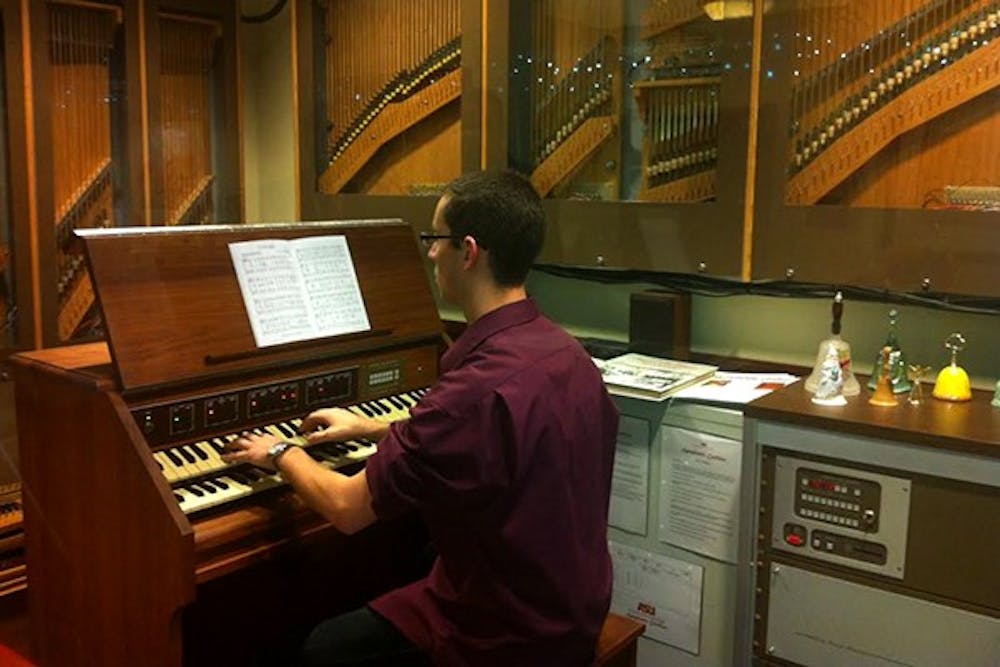 Jacob Hofeling is the official student player of ASU's symphonic carillon. Hofeling received a scholarship for playing the instrument. (Photo Courtesy of ASU Carillon Society)
Jacob Hofeling is the official student player of ASU's symphonic carillon. Hofeling received a scholarship for playing the instrument. (Photo Courtesy of ASU Carillon Society)
Junior Jacob Hofeling had been playing piano since he was 8, but he chose organ performance as his major so he could learn something new.
Hofeling became the Arizona State Credit Union Student Carillonneur in fall 2012, making him the official student player of ASU’s symphonic carillon, a unique instrument that uses tuned chimes to create bell-like tones.
“I’d never heard of (a carillon) until I came here,” he said.
Hofeling receives a scholarship as student carillonneur and plays and composes for the instrument on a regular basis.
He won the ASU Carillon Society’s inaugural composition contest and gave a performance of his winning composition, “Re-Awakening,” on Thursday.
Contest entries were anonymous and had to be composed exclusively for carillon.
His composition was modeled after Igor Stravinsky’s “The Firebird,” but the nature of the carillon meant he had to be more compressed in his composition, he said.
The necessity of compression is the major difference Hofeling has to deal with when working with the carillon instead of the organ.
“One note (on the carillon) contains about three or four notes within it, so you have to be careful not to mix certain pitches, because they will really clash,” Hofeling said. “So that was the main thing, was learning how to play with less.”
He said learning to compose for the carillon has made his organ compositions simpler and more open.
The carillon is unique for listeners as well as composers, he said.
“It’s a really one-of-a-kind instrument,” Hofeling said. “So for anyone to go see it and hear it in person, it would be almost a once-in-a-lifetime experience.”
Emma Whitten, Hofeling’s organ instructor and a doctoral candidate in musical arts, encouraged Hofeling to apply for the scholarship.
Whitten studied the carillon while she was pursuing her master’s degree at the University of Kansas.
She said the pedals and keyboard make the instrument similar to the organ.
“It’s a natural instrument for organists to choose,” Whitten said.
When she found out ASU was offering a scholarship for its carillon, she became interested and recommended it to Hofeling.
“He has not only the musical training, but a background in composition and popular music and music technology,” she said.
She said Hofeling attracts a modern audience by adapting popular songs to carillon, such as an arrangement he made of One Direction’s “What Makes You Beautiful.”
Carl Cross, University librarian and co-chair of the ASU Carillon Society, said the Associated Students of ASU purchased the 148-bell carillon in 1966 and dedicated it to those who lost their lives in the armed service.
The carillon was moved into storage a few years later so that Matthews Center could be made accessible to those with disabilities. It was forgotten for 30 years.
Cross said the instrument was reinstalled in 2005 but moved again because of a fire in 2007. It was put into its current place in Old Main in 2009, he said.
More bells have been added to the carillon since its rediscovery, and its 258 bells make it the largest Maas-Rowe symphonic carillon in the world, Cross said.
He said the bells, or “chime rods,” are tuned so that they can play three tones.
“They’re tuned so well that they can play harmonics,” Cross said.
Judith Smith, co-chair of the ASU Carillon Society, enjoyed listening to California State University, Long Beach’s carillon when she was a graduate student there in the 1970s, she said in a written account.
She said she heard rumors of ASU having a carillon when she started working as a publicist at the University in the 1980s, but she didn’t find definitive proof of the carillon’s existence until she stumbled across a catalogue listing for it while doing other research in the ASU archives in 2002.
She managed to locate the carillon and spent the next three years raising the $35,000 needed to refurbish the instrument, she said.
Smith said in an interview that the carillon’s keyboard was in “mint condition” and the bells were protected in cabinets when she found them, but it needed updated electronics and glass cabinets so it could be displayed.
“It was a very unexpected experience,” she said. “I just hope that it never gets lost again.”
Smith was motivated by prayer and history in her mission to restore the carillon, she said.
“People just love this instrument and people are so surprised when they come to see it, to hear it,” Smith said. “It’s a beautiful instrument. And it’s part of University history, too.”
Reach the reporter at ammedeir@asu.edu or follow her on Twitter @amy_medeiros




